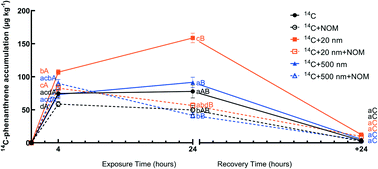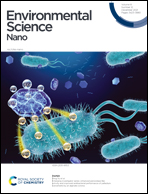The “Trojan Horse” effect of nanoplastics: potentiation of polycyclic aromatic hydrocarbon uptake in rainbow trout and the mitigating effects of natural organic matter†
Abstract
Massive annual production of plastics worldwide, coupled with prolonged environmental degradation and poor recycling policies has resulted in serious concerns regarding the ecological impact of these materials. Moreover, weathering of macro-sized plastic products in the environment results in increasing microplastics and subsequent nanoplastics in the environment. These smaller nanoplastics have an exponentially higher specific surface area with decreasing size. Hydrophobic organic pollutants in the environment are known to sorb onto the hydrophobic surfaces of plastics. Therefore, plastics can function as a vector for the uptake of contaminants to aquatic organisms (termed the “Trojan Horse” effect). Natural organic matter (NOM) is ubiquitous in all aquatic environments and can interact with organic pollutants and nanoplastics. However, research on the effects of NOM on the “Trojan Horse” effects of nanoplastics for hydrophobic organic pollutants is still minimal. This study investigated the potentiation of phenanthrene uptake (as a model polycyclic aromatic hydrocarbon) in rainbow trout fingerlings by nanoplastics and demonstrates that 20 nm polystyrene nanoplastics (PS-NPs) significantly increased phenanthrene uptake and induced higher EROD activity in both the gill and liver when compared to either larger 500 nm PS-NPs with sorbed phenanthrene or with the phenanthrene-exposed alone group. The presence of NOM reduced both phenanthrene uptake and EROD activity, especially in the presence of 20 nm PS-NPs, demonstrating the potential mitigating effects of NOM. Finally, we demonstrate that 20 nm plastic particles can transverse the epithelia of fish gills and are found in the liver 24 h after initial exposure. Moreover, while phenanthrene can be depurated from the fish within 24 h in clean fresh water, the 20 nm particles remain in the liver and gill tissue.



 Please wait while we load your content...
Please wait while we load your content...